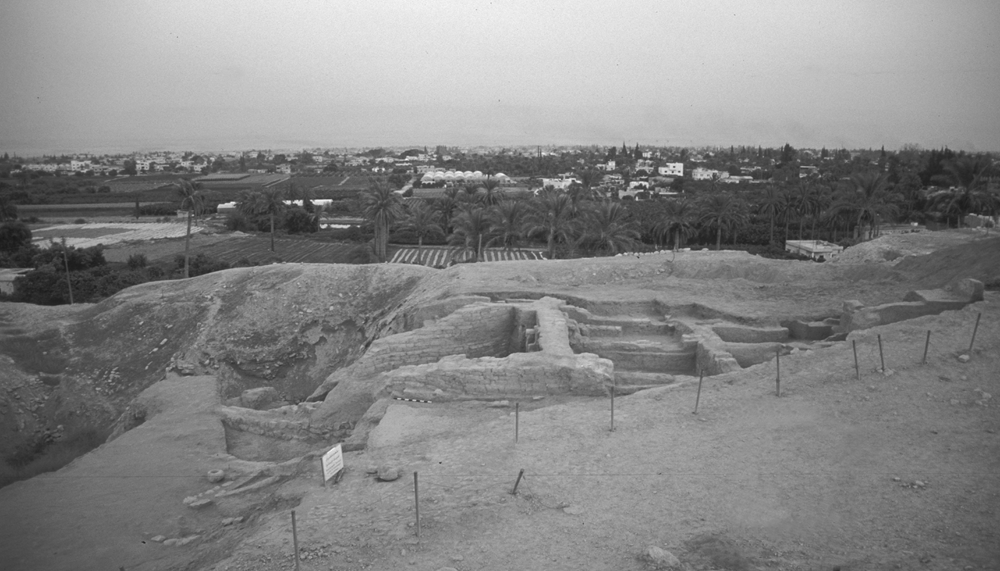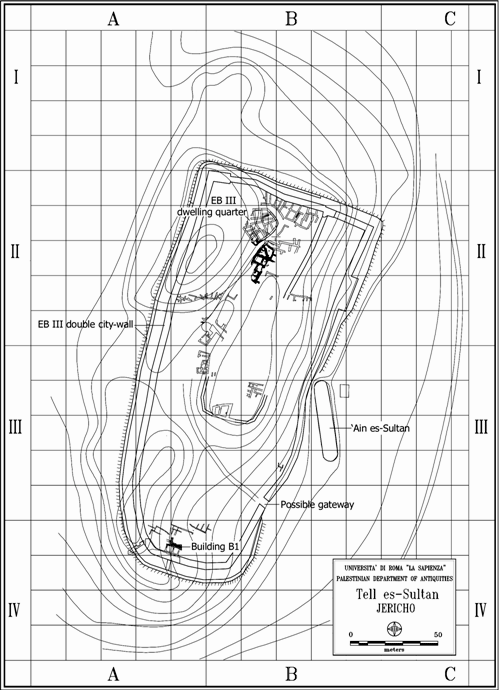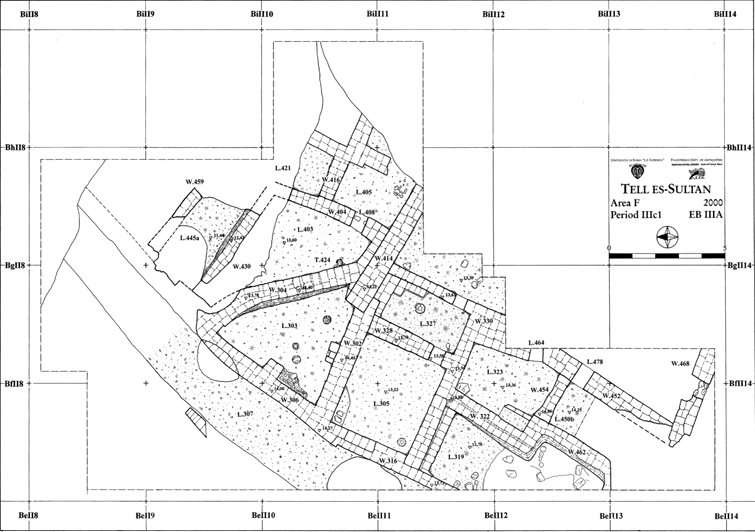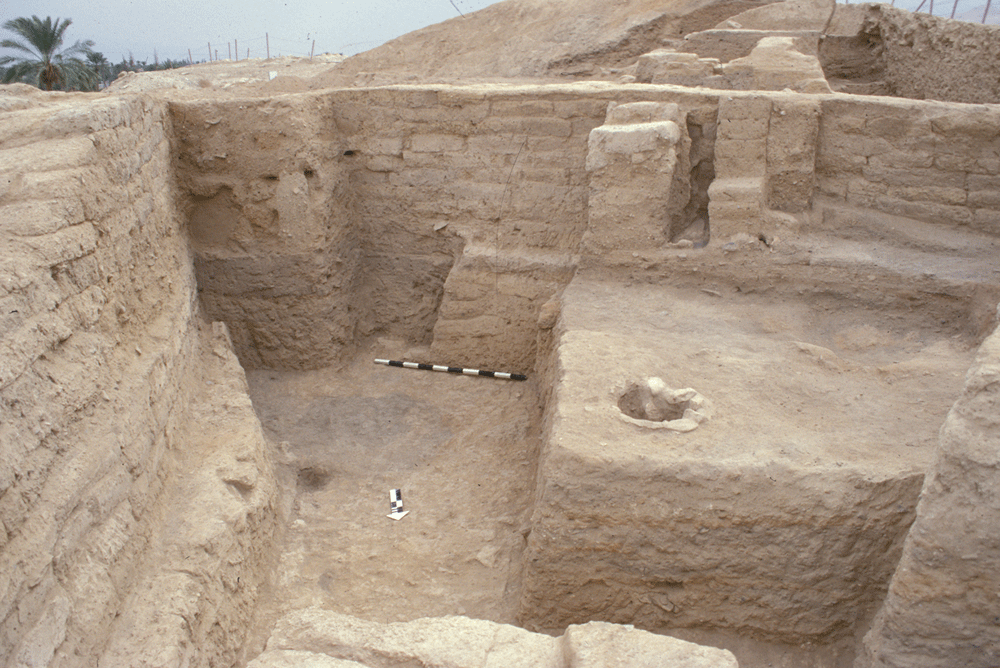The
main street crossing the city south-west/north-east was one of the
Sultan IIIb features kept in this period, as the excavations in Area F,
on the northern plateau of the tell, demonstrated. Here, a huge
portion of the dwelling quarter extending to the west and to the east of
the street running north-east, at this stage named L.307,
was brought to light. Eight
domestic units (from south to north, L.450, L.323, L.319, L.305+L.327, L.303,
L.403+L.405, L.445, L.904) in a fairly good state of preservation were exposed
on the eastern side of the street, and one more unit (L.444) was  uncovered on
its western side. Only L.904 opened directly towards the street, through
a doorway (L.902) with a raised threshold paved with three stone
slabs. Further to the north, the street was brought to light
up to the edge of denudation of previous excavations,
uncovered on
its western side. Only L.904 opened directly towards the street, through
a doorway (L.902) with a raised threshold paved with three stone
slabs. Further to the north, the street was brought to light
up to the edge of denudation of previous excavations, thus showing that the it turned slightly towards north-east.
Architecture shows the use of mud-bricks on field-stones foundations
only at the moment of the first erection of buildings. In the following
reconstructions, walls were raised horizontally, and new mud-brick
structures were built directly upon them without stone foundations.
This
made obviously quite complicated to investigate the constructional
history
of each house, also because the same houses were repaired many times and
continuously used with varying layouts. Each domestic unit was provided with a
hearth and various working installations, such as benches, cutting and grinding
slabs, pulping holes. Another common architectural feature is the use of timber
as pillars, often inserted within walls, or freestanding on
stone
bases, as known in many other Palestinian sites.
thus showing that the it turned slightly towards north-east.
Architecture shows the use of mud-bricks on field-stones foundations
only at the moment of the first erection of buildings. In the following
reconstructions, walls were raised horizontally, and new mud-brick
structures were built directly upon them without stone foundations.
This
made obviously quite complicated to investigate the constructional
history
of each house, also because the same houses were repaired many times and
continuously used with varying layouts. Each domestic unit was provided with a
hearth and various working installations, such as benches, cutting and grinding
slabs, pulping holes. Another common architectural feature is the use of timber
as pillars, often inserted within walls, or freestanding on
stone
bases, as known in many other Palestinian sites.
Findings belong to
the ordinary domestic assemblage, mainly illustrating food production and
preparation:
flint blades and sickles, stone pestles and grinding
stones. Faunal remains, among which several bones belonging to butchered
animals, show an integrated diet of tamed animals (sheep and goats, but
also bovines), and wild species, such as gazelle and wild boar. A
hippopotamus bone, found in the 1998 campaign, deserves a particular
interest; cutting marks indicate that it was butchered in the house. The
presence of such an animal in the Jericho Oasis not only is the latest
attestation in inland Palestine, but also testifies to the abundance of
water sources in the Lower Jordan Valley, especially by the �Ain es-Sultan
and the nearby �Ain el-Lodjia. The bull�s head found by John Garstang and made of
hippopotamus tusk
ivory may be, thus, locally manufactured,
as well as another similar specimen from an unknown spot of the site.
Other domestic activities are
testified to by items such as worked bones, bone and copper pins, and
loom weights and spindle whorls related to household textile production. Clay disks may be interpreted as counterweights used in
weaving activities, as they were found together with spindle whorls and
loom weights;
sea-shells and mother-of-pearl fragments hint at commercial links with
the Red Sea and the Mediterranean Sea. Especially, sea-shells have a
large attestation, being often pierced at their hinge, presumably in
order to be hung in laces. Due to their high number in EB
III contexts, anyway, it has been also suggested that they were used as
counters or represented some
sort of tallying system in a kind of
pre-administrative procedures.
Actually, the
existence of a productive system coordinated by a central
administration is perhaps more consistently demonstrated by findings
such as balance weights
(of 2 shekels and 1 mine), which are possibly related to metal and other
precious stuff (sulphur, salt,
ointments, drugs, bitumen, etc.)
exchange.
More rare finds are
metals, such as an arsenical copper pivot and
an enrolled foil, possibly belonged to wooden
furniture, as well as a worked bone cylinder,
decorated with a hatched motive, which is fairly typical of the
period.
The pottery assemblage of this phase included Simple Ware
vessels decorated with a reddish painting or wash,
Red-Polished Ware
(a globular juglet with a couple of knobs is a distinguished type), and various shapes of Khirbet Kerak
Ware.
The latter specialised
production seems to have a relatively wide attestation in the inventory
of Sultan IIIc1.
It is noteworthy that together with specimens clearly imported from
the North, mainly
retrieved in contemporary tombs, KKW fragments
from the site suggest the existence of a local
manufacture of such ware, which is distinguished by the firing (at a
slightly less high temperature, which results in a dark grey or
orange colour of surface, instead of black and red),
and by a
prevalence of small open
shapes such as slightly carinated bowls.

 A completely new composite
double city-wall was built � with separated juxtaposed blocks[11]
� all around the site, overlapping the previous solid wall only on the
western and part of the northern side. It was made of an inner main wall up
to 4.0 m thick, protected on the outer side by a filling sustained by an
outer wall (1.5-1.6 m thick). The gap between the inner and outer walls was
either filled up with crushed limestone (hawwara), or with soil
resulting from razing activities on the previous city collapsed strata, or
hosted blind rooms (a kind of �casemates�) related to the main wall and used
as storerooms or pathways[12].
This articulated system, which at several spots also foresaw a ditch at the
bottom of the outer wall, and reached an overall thickness of 12 m, was a
major achievement of the Jericho ruling institution in the Early Bronze IIIA,
and was at last investigated by the Italian-Palestinian Expedition in Area B
West[13],
at the south-west
corner of the site, where the nature of the filling in
between the inner and outer walls was clarified
[14], and the stratigraphy
A completely new composite
double city-wall was built � with separated juxtaposed blocks[11]
� all around the site, overlapping the previous solid wall only on the
western and part of the northern side. It was made of an inner main wall up
to 4.0 m thick, protected on the outer side by a filling sustained by an
outer wall (1.5-1.6 m thick). The gap between the inner and outer walls was
either filled up with crushed limestone (hawwara), or with soil
resulting from razing activities on the previous city collapsed strata, or
hosted blind rooms (a kind of �casemates�) related to the main wall and used
as storerooms or pathways[12].
This articulated system, which at several spots also foresaw a ditch at the
bottom of the outer wall, and reached an overall thickness of 12 m, was a
major achievement of the Jericho ruling institution in the Early Bronze IIIA,
and was at last investigated by the Italian-Palestinian Expedition in Area B
West[13],
at the south-west
corner of the site, where the nature of the filling in
between the inner and outer walls was clarified
[14], and the stratigraphy  of the two superimposed main
of the two superimposed main
 fortification systems
(previously interpreted by K.M. Kenyon as a sequence of at least 17
different phases), belonging respectively to Sultan IIIc1 and IIIc2, was
definitively established[15].
fortification systems
(previously interpreted by K.M. Kenyon as a sequence of at least 17
different phases), belonging respectively to Sultan IIIc1 and IIIc2, was
definitively established[15].
